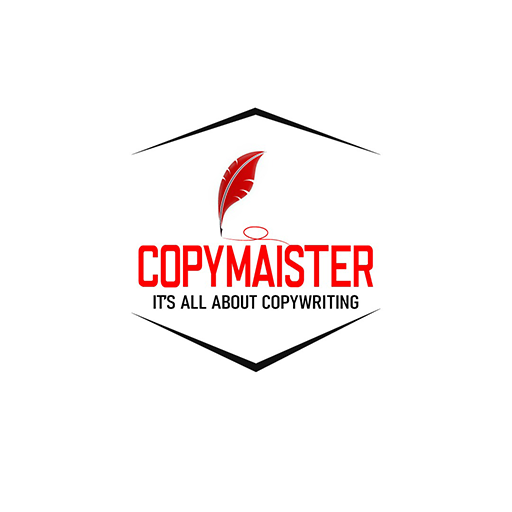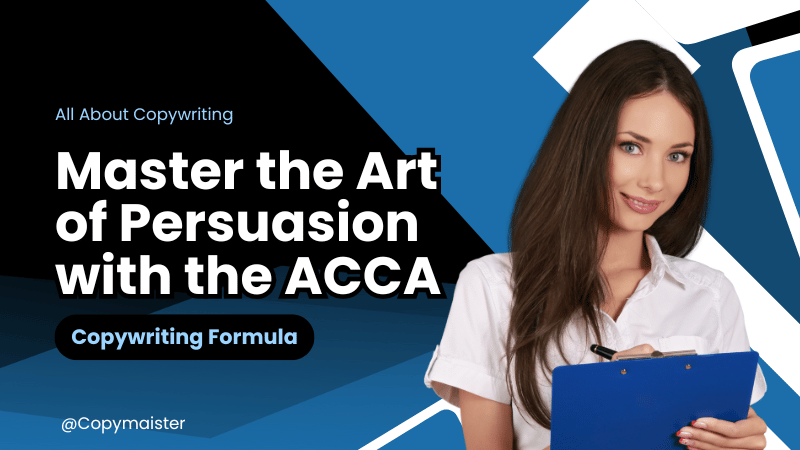Are you interested in learning to write a sales copy that grabs attention and converts?
Nowadays, most businesses lack an understanding of writing persuasive copy.
They focus too much on features, which makes their copy boring or completely fail to address the main pain point properly.
As a result, they miss opportunities, stagnate sales, and waste advertising dollars.
Suppose you don’t want to miss opportunities to convert your potential visitor into a customer.
In that case, you need to have proper command of a step-by-step framework, such as the AACA copywriting formula, which can help you tailor copy your audience can’t ignore.
ACCA copywriting formula helps you whether you are writing a landing page copy, sales email copy, or a social media ad copy.
Using this proven formula, you can craft copy that drives action and deeply resonates with your audience.
In this guide, you will learn how to effectively use the ACCA formula to write your copy.
By the end of this guide, you will be able to craft copy that not only sounds good but also increases your sales.
So, are you ready to elevate your copywriting?
If Yes!
So, let’s start.
What is the ACCA copywriting formula?
The term ACCA stands for Awareness, Comprehension, Conviction, and Action. This well-structured framework is designed to take a reader through a journey from recognizing the problem to taking action.
This formula is used to tailor high-converting persuasive copy.
Let’s break down this powerful copywriting formula into a four-step journey and understand each step:
- Awareness: In this step, you present the challenge or problem your target audience faces.
- Comprehension: In this step, you help your target audience understand how the challenge or problem is affecting them and why solving it is essential.
- Conviction: In this step, you briefly define why your solution is the best fit. Use storytelling, authority, and social proof.
- Action: Finally, to eliminate friction and encourage your target audience to take action, you should provide a clear and compelling CTA.
Analogy
In simple words, ACCA is like a road map that guides your target audience from doubt to decision-making.
Let’s make it simple and understand this formula with a simple example:
Suppose you are on a road trip. During the journey, you realize that you are lost (this is called Awareness).
Then, right after, you start to figure out where you went wrong (this is called comprehension).
Then you have seen your GPS and have a strong belief that it leads you back to the track (this is called conviction).
Finally, you fill up your car with gas and start driving (this is an action).
This is how ACCA works: it is a step-by-step guide that turns your hesitation into action and confusion into clarity.
How ACCA Copywriting Formula Works (Step By Step Breakdown)
In this section, you will explore how each ACCA step works and how to use this formula to write your copy.
So let’s start:
Awareness
The first step is to create awareness and make people think their pain or problem is impossible to ignore.
In this stage, all you need to do is address the pain or problem your target audience is facing with empathy and relevance. You have to show them that you understand what they have been through.
How to identify the pain or problem of your target audience:
- Use survey forms and ask your potential customers questions such as, “What is holding you back from achieving your goal?”
- Do competitor research, analyze their reviews of similar products as yours, and uncover the common frustrations of your potential customers.
- Monitor communities and forums to learn what your target audience is discussing and analyze their complaints or common frustrations.
- Instead of making general statements such as, “Our service or product solves problems,” paint a picture of your target audience’s pain points.
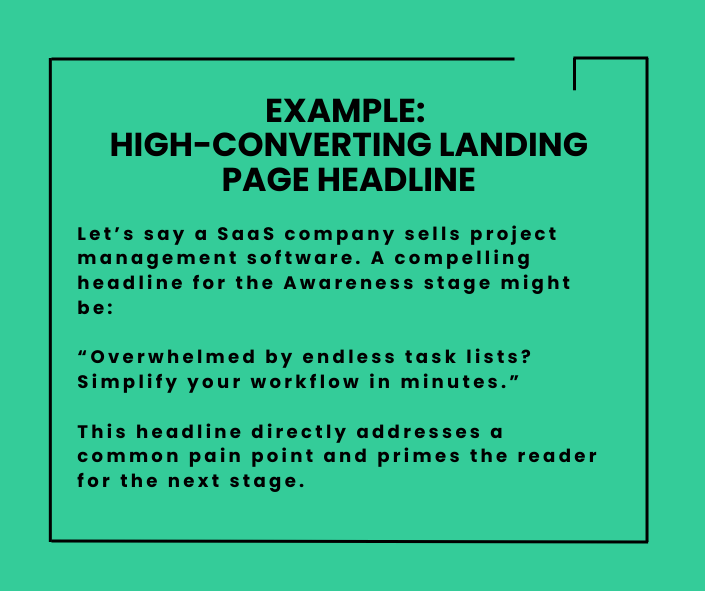
Comprehension
In this step, you must connect the problem or pain to your target audience’s reality and make them realize that those problems affect their lives. Amplify the consequences they may have faced, both logically and emotionally.
How to do it?
- Mention the stats that emphasize the importance of solving problems.
- Incorporate case studies or stories of your past customers facing the same pain or problem and how they overcome it.
- Connecting their problem with the goal shows them that they are such a big hurdle that stops them from achieving their goal.
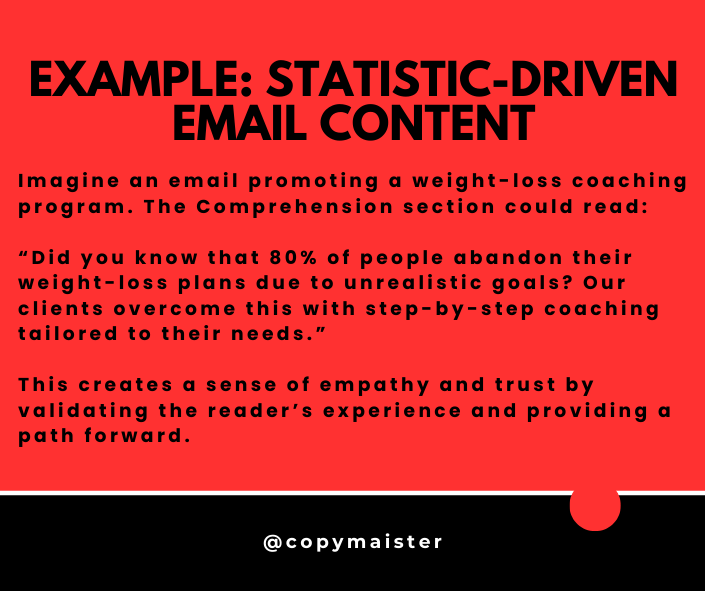
Conviction
In this section, all you need to do is prove your solution is the best fix because, at this stage, you have successfully established the relevance of your target audience’s problem.
Now, all you need to do is build conviction and position your solution as the best choice. You can do this by removing doubts, building authority, and providing social proof.
How to mention trust signals and social proof
- Mention the testimonial of your satisfied customers and share what they think about you.
- Incorporate case studies that paint a picture of before and after to demonstrate your solution’s impact.
- Showcase your trust badges, awards, security seals, expert endorsement, etc., to build your credibility.
- Make a comparison table where you compare your solutions with others to show why you can be the best choice.
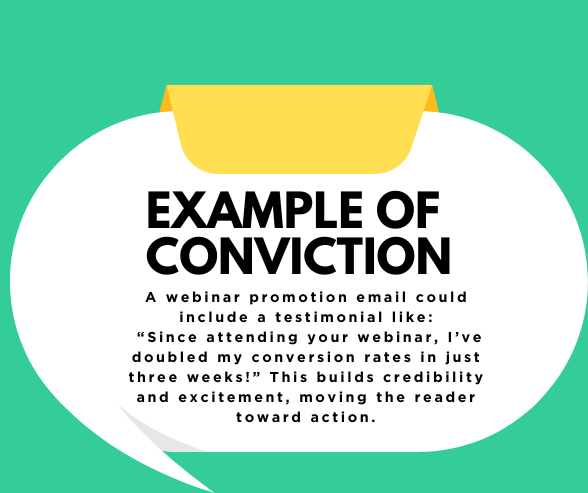
Action
This is the final stage, where you create an irresistible Call to Action (CTA) to encourage your reader to take immediate action to take advantage of your offer.
Best Practices for crafting compelling CTA.
- Ensure clarity and straightforwardness when mentioning CTA what you want your target audience to do.
- Create a sense of urgency to encourage your target audience to act immediately.
- Incorporating guarantees reduces the risk factors, such as “cancel anytime” or “money back guarantee.”
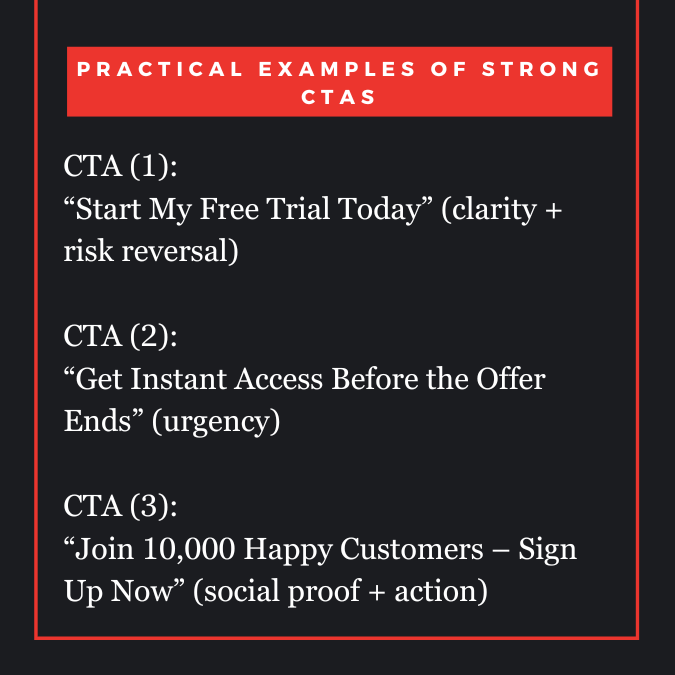
Where to use (ACCA)
Writing Landing Page
Use ACCA when writing copy for a landing page. When you work on a landing page, your main objective is to convert your visitor into a customer or lead, and with the help of ACCA, you can do this better.
Sales Email
For sales emails, it is important that your copy hooks readers and encourages them to make a purchase. ACCA helps because its structure helps you craft a clear path that guides your reader through pain points to present a solution.
Where not to use (ACCA)
Informational Blog
Don’t use ACCA when focusing on education or entertainment instead of sales because ACCA’s persuasive framework structure may feel forced.
Brand Storytelling Without Sales Intent
If you object to sharing your brand story to make an emotional connection instead of direct sales, ACCA is unnecessary in this situation. Other frameworks, such as story arc or narrative-building content, work better.
Conclusion
The ACCA formula is a powerful framework that helps you craft copy that grabs attention and converts your visitor into a lead or customer.
By following each step of this formula, such as:
- Awareness: To address the pain or problem with empathy and specificity to grab the attention of your target audience.
- Comprehension: Make them realize the consequences they will face in the future.
- Conviction: Guide them through removing their pain or problem and position your solution on top by building trust and credibility.
- Action: Encourage them to act fast with a compelling and clear Call to Action that adds urgency and removes friction.
By applying this formula effectively according to the guidance you have learned, you can help your prospects make decisions easily. This framework ensures that each step of your copy is designed to engage, resonate, and convert.
So that’s it for now. Thanks for reading the complete guide. If you have any questions, you can ask in the comments or send me an email.
